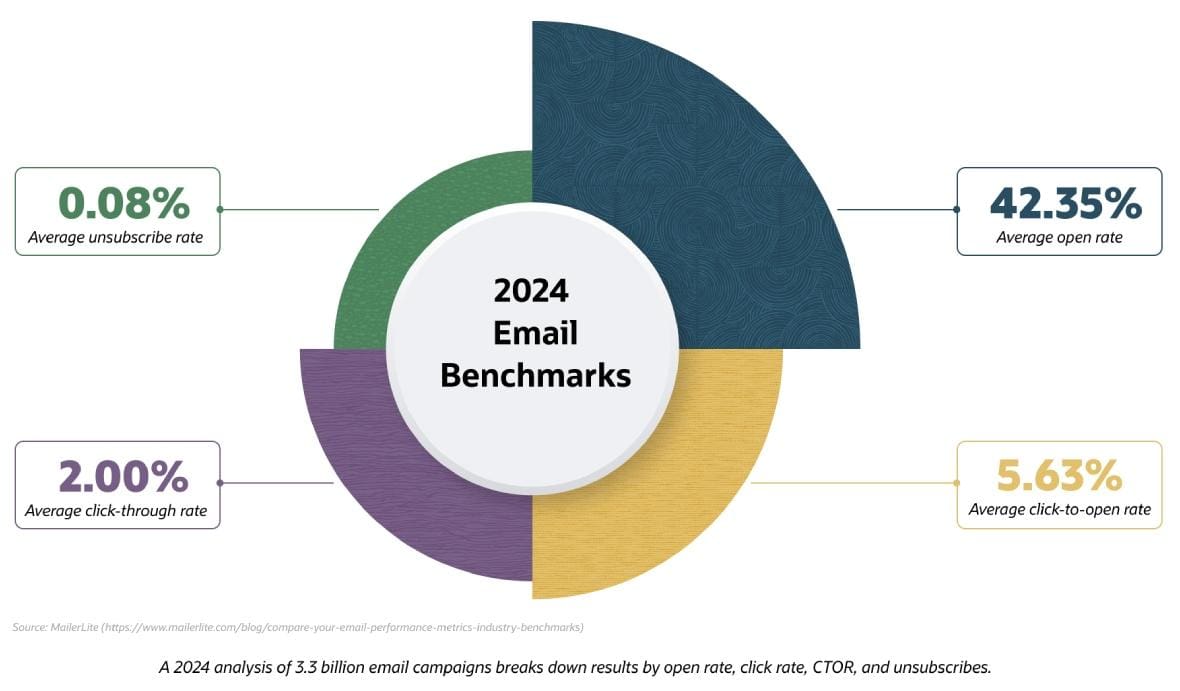An ecommerce company’s success depends on how well it understands statistics that track sales and measure operational performance. This article covers which key metrics businesses should monitor for ecommerce and why. Plus, you’ll find formulas and benchmarks to gauge the success of your online selling efforts.
What Are Ecommerce Metrics?
Ecommerce metrics measure the sales and business processes of a company that sells products online. For example, an ecommerce metric might show the number of website visitors that converted to customers or the average value of all customer orders.
Tracking these numbers gives companies insight into their overall performance and how their customers are shopping. They also reveal whether the business is on an upward or downward trajectory and whether their strategies are working, providing information that could shape decisions and future plans.
What Is the Difference Between Ecommerce Metrics and KPIs?
Ecommerce key performance indicators (KPIs) are a specific category of metrics that provide critical insights into the health of the business. KPIs can drive decisions and adjustments regarding strategy as needed.
A business should track KPIs to ensure that metrics stay in alignment with its business goals.
Key Takeaways
- Sales conversion rate is one of the most critical and widely used ecommerce metrics.
- Ecommerce metrics can be categorized by where a person is in the buyer’s journey, from discovery through advocacy.
- It’s vital to track other operational business metrics in concert with your ecommerce sales and marketing metrics for a big picture view that illustrates the relationships between these numbers.
How to Measure Ecommerce Success
The best way to measure ecommerce success involves tracking metrics and trends directly related to business goals. By comparing current ecommerce metrics against previous performance (e.g. this week compared to last week or year-over-year), the resulting analysis can show improvements or shortcomings. Regularly measure the most crucial metrics and consider changes based on what those metrics reveal.
How Often Should I Track Ecommerce Metrics?
Some ecommerce metrics warrant more frequent review than others. Some metrics will provide revealing insights weekly, while others showing longer-term and strategic guidance may only require evaluation at the end of each quarter.
Here’s a list of ecommerce metrics organized by how often most companies check them:
-
Weekly metrics
- Website traffic
- Social media engagement
- Impressions, or views, of digital ads
-
Biweekly metrics
- Average value of all customer orders (or “average order value”)
- Cost per acquisition of new customers (or “cost per acquisition”)
-
Monthly
- Open rate on marketing emails
- Percentage of customers who place products in an online cart but don’t complete the purchase (or “cart abandonment rate”).
-
Quarterly
- The total amount a company earns from a customer over the long term, representing many purchases over months or years (or “customer lifetime value”).
-
Campaign-based tracking for A/B testing
- A/B testing tests and tracks how customers react to a variation in a marketing message or campaign, such as sending promotional emails on Fridays versus Mondays, or the timing of a sale. This should be done regularly but is dependent on marketing campaigns and the frequency of email sends.
Frequency for Reviewing Ecommerce Metrics
Weekly Metrics
|
Bi-weekly metrics
|
Monthly
|
Quarterly
|
Top Ecommerce Metrics
Ecommerce companies have identified a number of metrics that help them better understand their operations and how they change over time. These metrics reveal how customers engage with the company, its products, and its website.
Here are 16 fundamental ecommerce metrics that most online sellers monitor:
-
Sales Conversion Rate
Divide the company’s total online sales volume by the number of visits to the online store to find this number. Many believe the sales conversion rate is the single most important ecommerce metric.
Sales conversion rate = Total transactions / Total visits x 100
The average ecommerce sales conversion rate is around 2% to 3%.
Since sales conversion rate is such an important metric, any incremental lift can make a dramatic difference in overall sales. To optimize each part of the shopping process, organizations can filter conversion rates by specific traffic sources or purchase paths to see which are strong and which need improvement. For example, conversion rates on traffic from different Facebook advertisements can highlight which campaigns are performing well. In this case, further monitoring of conversion rates for a certain category of products may reveal if they’re worth spending extra marketing resources to drive more category page traffic. (Learn more about other sales KPIs and metrics.)
-
Website Traffic
Website traffic measures the number of visits to a website, as well as visitor quality. Traffic is measured by total visits or total page views, and many companies pay close attention to how long the average visitor spends on the site. Website traffic comes from both paid (search and social advertising, retargeting, affiliate marketing) and free (organic search, social media, direct word of mouth, referral) sources. Businesses must invest time and effort into creating engaging content marketing and running cost-effective advertising to drive more website traffic.
-
Cost Per Acquisition (CPA)
Use this metric to determine the cost of acquiring a customer from a specific marketing campaign or the cost of encouraging a nonpaying user to take a certain action, such as submitting their contact information.
Cost per acquisition = Total spent on campaign to acquire new customers or users / New customers or users acquired
CPA can optimize campaigns for attracting new customers and identify the most/least effective marketing efforts when compared against the customer lifetime value (CLV)—as long as it’s cheaper to acquire customers than what they’re worth long-term, keep the traffic flowing. The best way to determine whether CPA meets the necessary threshold is by comparing it to CLV. The goal is to keep a profitable ratio, while reaching as wide an audience as possible.
-
Customer Acquisition Cost (CAC)
This metric is the total overall cost to acquire a new customer. CAC includes factors such as producing, storing, and shipping products. Ideal CLV targets should be three times the customer acquisition cost (3:1 ratio) to keep profitable customers.
Customer acquisition cost = Total marketing and sales expenses / Number of customers acquired
CAC is an essential metric for online retail because it tells businesses whether they’re operating profitably and earning more from new customers than they’re spending to acquire them. CAC also provides important insight into associated selling costs (sales rep overhead and commissions) beyond the lead acquisition spend. (Learn how the right platform can help B2B ecommerce companies succeed.)
-
Average Order Value (AOV)
A company’s AOV is the amount an average customer spends in a single transaction.
Average order value = Dollar value of all sales / Number of customer purchases
Companies typically target a higher AOV, but this number could vary greatly depending on what a business sells and how many items clients usually buy (think about a $40 order of household cleaning products versus a $2,000 furniture set, for example). Organizations can increase the AOV by selling accessory items for purchases at a discount or recommending associated items. Loyalty programs and offering free shipping on orders above a certain dollar value also help.
-
Revenue by Channel
Revenue by channel quantifies which advertising or communication channels are bringing in the most revenue.
Web analytics tools can monitor the revenue delivered through many different channels. These tools can also drill down to examine data from specific channels, such as YouTube, to calculate individual effectiveness of advertising. As per-channel measurements arrive, the ensuing analysis can drive decisions to optimize investments into each channel.
-
Micro to Macro Conversion Rates
Micro conversions are smaller actions a customer might take that lead to a larger goal, such as a sale. A micro conversion could be the number of visitors who click to see more product details or download a white paper. Those micro conversions can lead to macro conversions, such as purchasing a product or service.
An example of a micro conversion formula might be:
White paper download conversion = White paper downloads in a period / Total website traffic during that period x 100
By adding event tracking to a website (usually from analytics tool javascripts), companies can track these micro conversions and gain insight into how these smaller events cumulate into a macro conversion.
-
Customer Retention Rate
This metric measures how well a company maintains its customer base over a specified period of time.
Customer retention rate = (Customers at end of a time period – Customers acquired during the period) / Customers at beginning of period x 100
Businesses can increase their customer retention rate by improving customer service, creating loyalty programs, and offering discounts for repeat purchases. (Learn more about key customer-service KPIs and metrics, which includes tips for improving the customer experience.)
-
Shopping Cart Abandonment Rate
A company’s shopping cart abandonment rate gauges how often customers place products in a virtual shopping cart but leave the site before completing purchases. Most online retailers lose 60% to 80% of their shopping carts, with top performers only losing 25%.
Shopping cart abandonment rate = 1 – (Completed purchases / Number of shopping carts abandoned before checkout) x 100
This rate sheds light on whether the shopping and checkout process is customer-friendly or generates enough friction to lose potential customers. To reduce the cart abandonment rate, companies can make the checkout experience faster and easier to use. They can also retarget abandoners by sending emails or advertising campaigns to remind them that they didn’t complete the purchase.
-
Average Inventory Sold Per Day
This metric tracks daily sales velocity over a specific time period, such as a week or month. This metric works alongside the inventory turnover ratio to offer a more detailed view of inventory movement, informing shorter-term decisions about when to reorder and how much safety stock to have on hand. Monitoring these daily averages over time can identify sales trends—including fast- and slow-moving inventory— while anticipating seasonal fluctuations and driving adjustments to your marketing efforts accordingly.
Average inventory sold per day = Total units sold / Number of days in period
-
Repeat/Returning Customer Rate
Use this formula to measure the portion of customers who have previously purchased products or services. An acceptable repeat customer rate varies by the types of products sold. A wider variety of products and services improves the chances of repeat business.
Repeat/returning customer rate = Customers who made two or more purchases / Total customers x 100
-
Ecommerce Churn Rate
The ecommerce churn rate shows the quantity of customers or users a company loses over a specific period. Many customers churn away from a business as they lose interest in your products or services. Even if sales cycles take years to generate a repeat sale, strategies such as content marketing on email or social channels can keep shoppers engaged.
Ecommerce churn rate = Customers lost during a specific period / Total customers during that period x 100
-
Customer Lifetime Value (CLV)
Customer lifetime value measures the total amount of revenue a company receives from an average customer over the entire time they are a customer.
Customer lifetime value = Average order value in a period x Purchase frequency per period for average customer x Number of periods average customer is retained
This metric illustrates what an average customer means to a company’s bottom line—not just for a single purchase or even during a month or year, but over their entire lifetime with your company. You can increase this metric by increasing your customers’ purchase frequency or AOV. By providing pristine support and delivering relevant marketing campaigns, companies can drive more repeat sales from their existing customers. CLV can also help guide new customer acquisition spending as these metrics are usually compared to it.
-
Refund and Return Rates
This metric tracks how often customers return products as a percentage of your total sales.
Refund and return rate = Returns company accepted in a period / Total number of products sold in period x 100
Return rate can also be based on revenue:
Refund and return rate = Dollar value of all products returned in a period / Total dollar value of sales during period x 100
In order to attract first-time buyers, it’s important to have fair and flexible return policies to provide shoppers with peace of mind. However, companies should also seek to minimize return rates because processing returns is expensive. Analyzing return rates for specific products can determine whether some products are especially problematic. Websites should always have high-quality images and detailed product descriptions with specifications about all products to ensure customers understand what they’re buying.
-
Net Promoter Score (NPS)
NPS measures how likely customers are to recommend a company to other people. The average NPS varies significantly by industry. To get this score, companies send customers a survey asking them to rate the likelihood they would recommend the company on a scale of 0 to 10, with 10 being the highest likelihood.
Net promoter score = Percentage of surveyed customers who are “promoters” – Percentage of company’s surveyed customers who are “detractors”
Those who rate a company a 9 or 10 are “promoters. Those who rate it at 7 or 8 are “passives.” Those who give a rating of 0 through 6 are “detractors.” The resulting score can range from -100 to +100 based on the number of detractors. These surveys can uncover further helpful information by asking respondents to share the reason for their rating. Some experts suggest reaching out to detractors and passives to ask them how a company could improve.
-
Email Opt-in Rate
Email opt-in rate is measured by tracking how many new website visitors opt-in to receive emails from a company. An email opt-in rate is a good barometer of how people feel about a company and how interested they are in it.
Email opt-in rate = Number of people opting in for emails in a period / Website visits during period x 100
Email marketing remains an effective way to drive revenue and attract new customers, so a willing audience for marketing messages and emails is important. Rate improvement strategies include prominently displaying the opt-in option on your site and offering something of value to your visitors who sign up for emails, such as a discount on their first purchase.
Ecommerce Funnel Metrics
Several metrics can help companies understand how they’re moving potential customers through the sales funnel. The first stage of that funnel is a customer discovering the company, and later stages include acquisition, conversion, and advocacy. Tracking and evaluating ecommerce funnel metrics can identify any issues that prompt leading prospects to exit the funnel before they complete a purchase.
Discovery Phase Ecommerce Metrics
Use these metrics at each stage of the journey to track how potential customers find a website and better grasp movement through the stages of the buyer’s journey.
Impressions
Impressions are defined by any instance of a potential customer encountering a brand, whether through an online ad or another piece of content. An impression can happen through paid ads on third-party websites, Facebook ads, web search results, and in a variety of other ways.
An online analytics tool can identify the number of impressions received collectively or for any specific piece of content.
Reach
Reach represents the total number of people who see an advertisement or other content from a company. Frequently, reach refers to paid advertising content, such as a website or Facebook ad. The term also refers to a company’s email subscribers.
Think of reach as the number of unique people who see a company’s content, while an impression means that content was delivered to someone’s feed. Use digital analytics to measure a content’s reach.
Engagement
Engagement represents the level of online interactions people have with a company. Engagement measurements include a range of actions, including clicks on certain website pages, how long visitors remain on a website, or clicks on paid ads on other sites.
Web analytics tools can measure each of these metrics.
Acquisition Phase Ecommerce Metrics
These metrics look at the ways customers arrive at a website.
Traffic by Channel
This metric identifies the quantity of customers arriving at a website via specific channels, from social media to email campaigns to paid search. For example, social media ads may bring more visitors than other channels or SEO strategies have paid off to suddenly bring a surge in visitors. After reviewing these numbers, companies can increase investment in channels to optimize traffic.
Analytics platforms can track traffic by channel. (Read our guide to learn more about improving SEO for your ecommerce website.)
Traffic by Location
Knowing a customer’s geographic location demonstrates market reach across different regions, countries, and cities. This metric weighs market expansion opportunities, optimizes marketing spend in high-performing regions, and identifies untapped markets with growth potential. It’s also helpful for tailoring website content, pricing strategies, and product offerings to match regional preferences.
Cost Per Acquisition (CPA) by Channel
This metric uses revenue by channel to identify how successful marketing investments are in attracting customers. The formula is similar to the cost per acquisition formula, except it focuses on costs for a specific channel.
Cost per acquisition by channel = Total spent on certain channel to acquire new customers / New customers acquired through channel
The metric determines the best investment for attracting new customers. Most new customer acquisition efforts are tracked as marketing campaigns; website analytics tools can filter traffic sources and channels/mediums.
Email Open Rate
An email open rate is the percentage of people who receive and open marketing emails from a company. Email marketing or marketing automation systems can track this metric.
Email open rate = Number of people who open marketing emails / Number of marketing emails sent x 100
The email open rate might vary based on the day, time of day, or time of year in which an email was sent, along with the frequency of messages sent in a campaign. (Learn more about marketing KPIs and metrics.)
Unsubscribe Rate
An unsubscribe rate is the percentage of subscribers on an email list who unsubscribe from regular newsletters or other emails.
Unsubscribe rate = Unsubscribe requests / Total number of emails sent to list
Email List Growth Rate
This metric monitors the expansion of email subscription lists. The number changes as new people sign up to receive emails and others unsubscribe from the list.
Email list growth rate = (New subscribers during period – People who unsubscribed during period) / Total subscribers at beginning of period x 100
Email Conversion Rate
This formula measures the percentage of email recipients who open messages and take another intended action, such as completing a purchase or downloading a brochure.
Email conversion rate = Email recipients who complete intended step after clicking through email / Total email recipients x 100
Email Click-Through Rate
This rate calculates the number of email recipients who open the email and click on a link.
Email click-through rate = Email recipients who complete intended step after clicking-through email / Total email recipients x 100

Ecommerce Conversion Metrics
These metrics demonstrate how effective an ecommerce site is in converting visitors into customers.
Conversion Rate by Channel
A more specific version of the overall sales conversion rate, this metric tracks sales conversions based on the channel that drove the arrival. For example, a company may track separate conversion rates by social media ads, third-party website ads, or organic search engine rankings.
Conversion rate by channel = Total sales derived from specific marketing channel / Total visits from specific channel x 100
Bounce Rate
Not all who come will stay beyond the first page they land on. Bounce rate measures the percentage of visitors who leave a site quickly after their initial arrival. This metric offers a snapshot of user engagement and, if low, can be indicative of lackluster content, poor design, a slow load time, or another issue that compels them to hit the back button.
Bounce rate = (Number of single-page sessions / Total number of sessions) x 100
Add-to-Cart Rate
This metric measures the percentage of website visitors who add products to their virtual shopping carts, including those who add products but don’t actually make a purchase.
Add to cart rate = Website sessions where visitor adds products to cart in a specific period / Total sessions during that period x 100
Checkout Abandonment Rate
This metric is related to but different from the shopping cart abandonment rate. Checkout abandonment rate measures customers who go beyond the shopping cart and start the checkout process but do not complete a purchase. It’s important to measure this separately from shopping cart abandonment—measuring both will help clarify where in the checkout process is the primary source of friction.
Checkout abandonment rate = 1 – (Completed purchases / Number of checkout processes started but abandoned) X 100
Average Order Value by Channel
This measures the AOV explained above but is based on the channel that brought the customer to a website.
Average order value by channel = Dollar value of all sales through specific channel / Number of sales initiated by that channel
Ecommerce Retention Metrics
These numbers show whether a company is effective at holding onto customers who have previous purchased products or services from the business.
Early Repeat Customer Rate
A variation of the repeat customer rate, this metric gives insight into the number of repeat customers who make another purchase a short time after their first purchase.
Early repeat customer rate = Customers who made second purchase within defined short time period after first purchase / All customers who made first purchase in period x 100
Program Participation Rate
This formula measures participation in any customer-focused programs, such as loyalty programs. Higher participation in such programs generally translates to repeat customers.
Program participation rate = Customers part of a program in a specific period / Total customers informed about the program in period x 100
Customer Advocacy Metrics
Customer advocacy metrics provide insights into the portion of customers who go beyond loyalty to become advocates for products or services.
Social Media Engagement
Measuring social media engagement with specific web pages offers insights into how potential and existing customers react to products and services, as well as marketing and social media campaigns.
Closely monitoring social media engagement also helps develop deeper relationships with customers, fosters loyalty, and provides guidance on how to improve products.
Companies can Measure Social Media Engagement by Monitoring:
- Likes per post (includes “likes” on Facebook, X, and LinkedIn, or similar affirmations on other platforms)
- Shares per post (includes shares on Facebook and LinkedIn, retweets on X, etc.)
- Comments per post
- Clicks per post
Ecommerce Metrics Dashboards
Ecommerce metrics dashboards are often part of ecommerce software or an ecommerce platform. They give company leaders a sense of how their ecommerce operations are performing and any meaningful trends that may shape their strategies. With input from a variety of stakeholders, companies should decide on a handful of KPIs and other metrics to track that align with big-picture goals and make it easy to see the status of online sales.
Two categories of metrics are especially important to include on a dashboard. One category includes metrics that illustrate the financial health of your business—revenue, profits, costs, and the like. The other category includes measurements for overall website traffic, traffic by channel, and engagement.
- Website traffic
- Average order value
- Customer acquisition cost
- Sales conversion rate
- Customer retention rate
- Cart abandonment rate
(Learn more about operational KPIs and metrics to understand how to measure a company’s operational efficiency.)
Companies should make sure they understand the differences between an on-premises and cloud ecommerce platform to determine which is right for them. They should also select a system that has built-in reporting capabilities that will make it easy to track the metrics outlined here and others critical to their business.
Break Down Ecommerce Metrics Silos
Successfully running an ecommerce business requires monitoring dozens of metrics across multiple business functions—from website performance and customer behavior to inventory levels and financial health. NetSuite’s SuiteCommerce solution simplifies data collection with a unified repository that connects metrics from finance, operations, inventory, sales, and marketing, providing decision-makers with real-time visibility into how each part of the business is impacting company goals and making it easier to catch problems early on.
For example, if a sale causes a 50% spike in conversion rate, can current inventory levels keep up with demand? Is a certain advertising channel still profitable if the cost per acquisition keeps climbing? NetSuite’s cloud-based software ensures businesses maintain sufficient stock for increased demand, adjust staffing levels appropriately, and update financial forecasts to account for both the campaign costs and expected revenue surge. By consolidating ecommerce data into one suite, NetSuite provides the insights needed to make informed decisions that drive business growth.
Ecommerce Metrics FAQs
What are the four basics of ecommerce?
There is no set list or number of items, but some experts point to the following pillars: customer acquisition/retention, conversation optimization, brand awareness, and data analytics. Technology and tools, such as cloud computing and automation, serve as the foundation for these pillars.
How do you know when an ecommerce category is doing well?
Strong sales conversion rates, healthy profit margins, and consistent or growing traffic are all signs of a thriving ecommerce category. Metrics like average order value, inventory turnover rate, and return rates specific to that category help measure category performance.
How do you benchmark a KPI?
A business must first establish its current performance baseline and then compare it against industry standards, competitor performance, and historical data. Set realistic targets based on these comparisons, then track performance using analytics tools to monitor progress.








